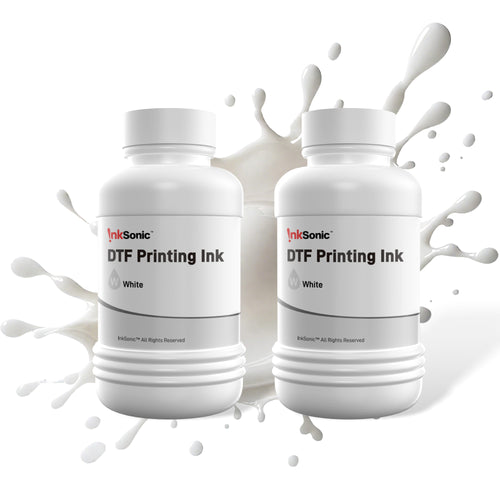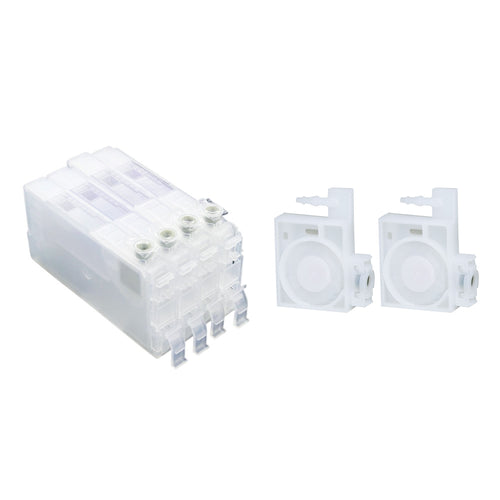Determining the right DTF printer can be overwhelming considering all the specs, features, and technical language used to describe printers, including white ink circulation, heated printing platens, and print resolution. As a hobbyist, small business owner, or when starting your own custom T-shirt shop, this guide will provide you with knowledge on which DTF printer will help you be successful in achieving your goals, satisfy your space, and be right for your budget.
What Is DTF Printing
In 2025, personalization is on fire in high demand—a Statista report states the global custom T-shirt printing market is expected to reach $9.18 billion by 2032 and grow at a CAGR of 11.1% from 2023 to 2032 . Meanwhile, hybrid technologies like UV DTF and eco-solvent ink solutions are the thing, driven by a growing trend towards sustainable and multi-surface print in craft and commercial markets.
DTF (Direct-to-Film) printing is a digital transfer process where graphics are printed onto a specialty film and then heat-pressed directly onto many materials - cotton, polyester, blends, leather, etc.- without pre-treatments.
DTF is much more versatile and easier to maintain than its other counterpart, DTG (Direct-to-Garment), which is limited by the cotton apparel, and pre-treatments needed.

Key Factors to Consider When Choosing the Best DTF Printer
There are a lot of considerations when deciding on which DTF printer to procure. It can be overwhelming, but these are the important things to consider in order to make a good decision based on your goals, volume, and budget.
1. Your Usage Scenario
Before you get into specs, clarify your purpose. Are you going to be using the printer for home crafting, selling T-shirts from home, or for a commercial business?
Small models like A3 or A4 DTF printers with controls can suffice for recreational users.
Small business proprietors need to find machines that neither sacrifice speed nor print quality nor user-friendliness.
Commercial enterprises need industrial-level DTF printers with dual printheads, bulk feeding, and high-speed capability.

Your operating situation directly determines what features and specs are most valuable.
2. Print Size Compatibility
DTF printers come in multiple print size formats, so choose one that fits your product range:
A4 or A3 : Ideal for beginners or limited workspace.
13-inch or 24-inch : Suitable for growing businesses handling custom clothing, tote bags, and more.
60cm+ wide-format models : Designed for bulk and commercial printing with roll-to-roll output.
Larger print sizes offer more flexibility but usually come with higher cost and space requirements.
3. Printhead Type
The printhead is the engine of your printer, so it’s critical to choose wisely.
Popular options include:
- Epson L1800 : Affordable option for beginners and the slowest speed.
XP600 : Best balance of speed and quality; often preferred in commercial entry models.
Epson i3200 : Industrial speed and printing quality; aimed at serious production.
Tip : Faster printheads save time but may come at a higher upfront cost. Consider your workload before choosing.
4. Ink System and White Ink Circulation
White ink is crucial in DTF printing, but it’s also the most problematic if not handled correctly. A stable white ink circulation system is essential to prevent clogs and sediment buildup.
Look for systems with:
- 3-in-1 circulation : Combines ink mixing, filtration, and circulation to keep ink flowing smoothly.
Auto start/stop functionality: Activates circulation when the printer is powered on, reducing manual intervention.

This feature alone can extend your printhead’s life by 50% and reduce maintenance headaches.
5. RIP Software & Compatibility
Your printing software (RIP) controls how designs are processed and printed.
Look for RIP software that allows:
- Spot color and white layer control
Easy interface for layout adjustments
ICC profile support for consistent colors
RIP software compatibility also affects your learning curve and print accuracy.
6. Film Feeding System
DTF printing relies heavily on precise film feeding. You’ll want a machine that handles film efficiently:
- Roll mode: Ideal for continuous, high-volume jobs.
Sheet mode: Great for smaller, one-off prints.
Suction system or pinch rollers: Help keep the film flat, prevent warping, and reduce jams.
Printers with adjustable suction control or auto film loading improve print consistency and reduce user error.
7. Maintenance and Support
Maintenance can often be an afterthought, but it can greatly impact your printer's uptime and longevity.
Look for:
- Auto-clean: It periodically flushes ink from nozzles and collects waste ink.
Easy to spare parts: User replaceable ink pads, wiper blades and capping systems.
Support: Select brands that have videos, manuals, live chat or remote support.
8. Budget and Total Cost of Ownership
Price is more than just the machine. Consider:
-
Upfront printer cost
Recurring costs : ink, PET film, DTF powder
Spare parts and consumables
Expected maintenance frequency
Long-term ROI potential

A low-cost printer with high maintenance costs can cost more in the long run. You want to make sure that the printer is affordable but will provide you with something that works reliably and minimizes your running costs.
Recommended Models for Different Users
Considering so many DTF printers available in 2025, the choice is highly dependent upon your level of business, production needs, and technical knowledge. Following is a basic guide that will help you get the best appropriate kind of printer for your requirement.
Recommended for Beginners: A4 / A3 DTF Printers with Ease of Use
If you are new to DTF printing - as a hobbyist, part-time business owner, or professional creative - we recommend you start with a small and easy-to-use printer.
Look for items with A4 or A3 print shops. These are suitable for low-quantity production, test prints,or small orders.
They are also good if you are new to business or if you want to test the water without scaling the business too fast.
Best for Small Businesses: Mid-Range Models with Fast Output
For tiny businesses printing 10–50 shirts per day, a mid-range printer offers the best compromise between speed, reliability, and cost. These printers usually come with more durable printheads, wider format support (13\" or 30cm), and more even film movement.
Best for Production Scale: 24"+ DTF Printers with Dual Heads
For high-volume commercial printing applications, you will need to buy a wide-format DTF printer (24-inch and above) with dual Epson i3200 printheads, or similar. These are fast printers that are designed for running multi-shifts. Perfect for established custom apparel companies or third-party print services.
This industrial-grade machine is ideal for production shops that demand high efficiency, minimal downtime, and consistent quality in large quantities.
L1800 DTF Printer: Still Relevant in 2025?
If you’re researching DTF printers in 2025, chances are you've come across the L1800 DTF printer, especially in discussions around budget-friendly or beginner-friendly setups. This is one of the most popular models currently on the market.
What is the L1800 DTF Printer?
The A3 DTF printer L1800 is based on Epson's L1800 photo printer, adapted for Direct-to-Film printing with specialized ink systems and RIP software. It remains popular with entry-level users because of its affordability, compact footprint, and relatively simple operation.

Print Size : A3 (ideal for small designs, T-shirts, tote bags)
Print Speed : 5–8 minutes per A3 print (much slower than XP600 or i3200)
Best For : Beginners, hobbyists, low-volume shops
R1390 vs. L1800: Which One's Better?
Many users also compare the R1390 vs. L1800 when choosing an A3 printer. Both use older Epson printhead tech and offer similar resolution.
The printhead is the same in the R1390 & L1800 DTF Printer. The main differences between the R1390 and L1800 are:
- Motherboard: The L1800 features a more stable motherboard compared to the R1390.
Output Platform Heating Feature: The L1800 includes output platform heating, which helps prevent ink flow and ensures optimal print quality. This feature is not available on the R1390.
Other parameters are compared in this chart:
Printer Specifications |
Print Width |
300mm/12in |
300mm/12in |
Channels |
6 channels |
6 channels |
|
Motherboard |
R1390 |
L1800 |
|
Printing Speed |
A3/5-8 minutes |
A3/4-6 minutes |
|
Highest Resolution |
Recommend 1440*1440 DPl, Maxium 2880*2880 DPI |
Recommend 1440*1440 DPl, Maxium 2880*2880 DPI |
|
Cartridge Capacity |
260ml |
260ml |
|
Color |
CMYK+WW |
CMYK+WW |
|
Ink Consumption |
10ml/㎡ 0.93 ml/ft² |
10ml/㎡ 0.93 ml/ft² |
|
Nozzle Holes |
90 holes per channel |
90 holes per channel |
|
Number of Nozzles |
1 |
1 |
|
InkSonic™ Upgraded Feature |
White Ink Circulation & Stirring & Filtration |
Yes. Adjustable Intensity |
Yes. Adjustable Intensity |
Air Suction Platform |
Yes. Adjustable Speed |
Yes. Adjustable Speed |
|
Waste Ink Collection |
√ |
√ |
|
Heating |
× |
√ |
|
Nozzle Self-cleaning |
√ |
√ |
|
Nozzle Moisturizing |
√ |
√ |
|
Visibal Ink Monitor |
√ |
√ |
|
Inspection Door: Motherboard |
√ |
√ |
|
Inspection Door: Ink Cartridges & Motherboard & Raster |
× |
× |
Occasional Use: The R1390 is a budget-friendly option, ideal for beginners who wanna buy an A3 size DTF printer and use the printer occasionally.
Frequent Use or Stability Requirements: The L1800 offers a more stable motherboard and heating functionality, making it a better choice for those who use the printer frequently or require enhanced stability. However, it comes at a higher price.
Is the L1800 the Best DTF Printer for T-Shirts?
While the L1800 is a great starting point, it's not the best DTF printer for T-shirts if you're aiming for business scalability. If you plan to print more than 20–30 shirts a day, upgrading to an XP600-based model is more efficient in the long run.
Best DTF Printers of Recommended Picks
After comparing a range of high-performing A3‑size DTF printers, the InkSonic XP600 A3+ U13 stands out as the top recommendation for most users, particularly those running small businesses or design studios.

Why the XP600 A3+ Printer U13 shines
Super-Fast Printing via XP600 Printhead
Equipped with the Epson XP600 printhead, the XP600 U13 delivers ultra-fast A3 prints in just 3–5 minutes , compared to around 5–8 minutes on earlier L1800‑based models. This translates to 200% faster throughput —ideal for businesses needing higher daily volume (around 200+ prints/day).

Can Pair with Powder Shaker & Dryer System
The U13 can be paired with an automatic powder shaker&dryer to vibrate and cure the binder powder immediately after ink application, eliminating delays and doubling productivity compared to manual systems.

Intelligent White Ink Circulation
A built-in 3-in-1 white ink system (circulation, mixing, filtration) significantly reduces clogging and printhead issues—reducing maintenance frequency from every 3 days down to every 2 days at high usage. The U13 supports holiday mode with automatic cleaning intervals for added protection.
Simple Maintenance & User-Friendly Operation
Daily maintenance takes less than 2 minutes. The U13 features automatic nozzle flushing and clear ink level monitoring, making upkeep simple even for beginners.
Where XP600 U13 Outshines Other Models
Feature |
XP600 A3+ U13 |
Other Brand Models |
Print Speed (A3) |
3–5 minutes |
5–8 minutes |
Daily Output |
~200+ shirts |
~100 or fewer |
Auto Powder & Oven |
Yes |
No or optional |
White Ink Circulation |
3‑in‑1 auto continuous system |
Basic or manual mixing |
Maintenance Frequency |
Every 2 days |
Every 3 days or more frequently |
Warranty & Support |
Included, extensive |
Varies, often limited |
The InkSonic XP600 U13 provides the best combination of speed, quality, automation, and on-going support to users looking to expand their DTF printing business. Whether you're starting small, or can't walk past the printer without putting it into high-volume production, this model can provide reliable stability, minimize downtime, and has smart automation. There are industrial models that may suit production-based high-volume users, however, the U13 model is still the best model for efficiency and value in 2025.
Tips to Maximize Your DTF Printing Success
To obtain maximum benefit from your DTF printer—and protect your investment—quality supplies, good daily routines, good material handling, and attention to quality are called for. These are some professional-endorsed recommendations that contribute to a smooth and consistent operation for your DTF printing process:
1. Perform a nozzle check and print test before printing
Nozzle check is crucial, especially when it comes to white ink. This quick diagnostic print can help you detect clogged nozzles or abnormal ink flow before they affect your print output.
Why it matters:
- Prevents wasted film and ink from bad output
Catches minor clogs early before they become severe
Ensures your printhead remains in good working condition

Tip: Make this a part of your daily startup routine—even on slower production days. It only takes a few seconds but can save you hours in troubleshooting.
2. Store DTF Film and Powder Properly
DTF supplies are hinging potentially sensitive to environmental factors such as humidity, heat, and light. If you store your supplies properly, you will have better print adhesion, powder curing, and transfer performance.
Best practices:
- Keep the film in a cooler storage area with room temperature and normal humidity ( 40%-60% ) to be sure not to affect how the products perform with adhesion, powder curing, and transfers.
Do not store in direct sunlight this could potentially warp or curl the film.
Store DTF powder in airtight containers in a cool and dry place. It is best to store in a cool area away from humidity and moisture to reduce clumping and potentially prevent moisture contamination.

3. Maintain White Ink Properly
White ink is the most problematic part of DTF printing since it contains a heavier pigment (titanium dioxide) which settles very quickly. Poor maintenance of white ink causes nozzle clogging, irregular output, and print failure.
To keep white ink performing well:
- Shake white ink bottles (30–60 seconds before printing)
Activate the white ink circulation system (if your printer has one)—even if you're not printing
Run white ink-only nozzle tests regularly to check for blockages
Clean the white ink lines and dampers weekly if you print frequently
4. Use High-Quality Inks and Supplies
Not every DTF ink, film, and powder is the same. Business owners will often choose the cheapest option available, in terms of supply, which can sometimes be the least costly choice in the long run, however, they may then experience clogged print nozzle(s), poor adhesion of the white ink used, dullness and washability (cracking, fading, etc.), and/or an unpredictable result.
Note: Always purchase supplies from verified sellers, and do not mix brands of inks. If only non-industry brands survive in your area, I suggest testing to determine compatibility with your processes.
These tips together are important and will form the basis of a successful and extended DTF printer workflow - whether you are printing a few shirts a day, or operating a DTF printing business in high-volume.
5. Long-Term Care: Use an External Moisturizing Device if Idle for Weeks
However, if your DTF printer is not being used, you must protect the printhead if that period extends beyond 3 to 5 days, protecting it from drying out or clogging, especially if you are printing with white ink.
Why it matters:
- Prolonged inactivity allows ink to dry inside the nozzles
White ink sediment can harden, causing deep clogging
Standard cleaning functions may not be enough after extended downtime
Solution:
Install an external moisturizing device (also called a moisturizing cap or humidifying pad). This tool keeps the printhead surface moist and sealed, preventing ink from drying in place.
Best practices include:
- Turn off and unplug the printer before installing
Ensure the moisturizing pad is saturated with cleaning solution or humidifier fluid
If storing long-term, clean the printhead and lines before using the moisturizing cap
Choosing the Right DTF Printer in 2025
Selecting the right DTF printer is not just about comparing specs — it’s about aligning the technology with your business goals , production volume , and growth potential . As we’ve explored in this guide, several factors play a role in making a smart purchase:

- Usage matters — A beginner hobbyist doesn’t need the same machine as a growing apparel brand. Match your machine to your scale.
Print size & speed — Whether you choose an A3, 13-inch, or 24-inch printer depends on your product range and production frequency.
Printhead choice — L1800 for starters, XP600 for balanced speed and quality, i3200 for high-volume production.
White ink circulation systems and film feeding mechanisms are essential for smooth, consistent results.
Reliable support and maintenance help reduce downtime and protect your investment.
Assess Your Goals Before You Buy:
Are you planning to sell a few shirts a week on Etsy? Or are you fulfilling hundreds of orders for brands and events?
Take time to assess:
- Your daily production needs
Available workspace
Level of technical confidence
Budget for both upfront and ongoing costs
This self-assessment ensures you don’t over- or under-invest in a printer that either limits your growth or adds unnecessary complexity.
Why 2025 Is the Best Time to Invest
The DTF industry has rapidly matured in recent years.
- Printer technology is more reliable , faster , and cheaper than ever before
A wide range of entry-level and professional models makes DTF accessible to almost anyone
Customization trends in fashion, events, merch, and corporate branding continue to rise
Global demand for on-demand, short-run printing is driving long-term opportunity

Whether you're just entering the market or scaling your current operation, now is an optimal time to leap.
Explore InkSonic’s DTF Printer Lineup:
If you’re ready to choose your machine or want help narrowing it down, visit our full lineup here:
Need help? Contact our 1-on-1 support team for guidance tailored to your goals.




































